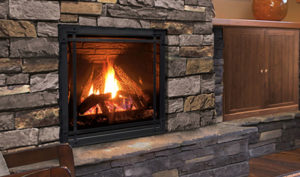Did your wood-burning fireplace sit mostly unused this winter? Are you tired of hauling wood and tending your fireplace? If so, it might be time to upgrade to a gas-fueled fire! Here’s what you need to know about upgrading to gas.
 The benefits of a gas fireplace.
The benefits of a gas fireplace.
Gas fireplaces have become the most popular options for homeowners installing new fireplaces, and it’s easy to understand why. Gas fireplace technology has advanced in the last decades. Nowadays the flames of a gas fireplace closely mirror the warm, yellow glow of a wood-burning fire. Unlike wood fires, however, gas fires are available at the touch of a button or the flip of a switch. In addition, they can be turned off just as easily. Gas fireplaces also can be wired to a thermostat to help control the heat output from the fireplace and the temperature in your home.
Gas fireplaces also are tops when it comes to efficiency. An open-hearth wood-burning fireplace returns only 10 percent of the fire’s energy as heat to your home. However, a gas fireplace can return between 75 and 99 percent of the fire’s energy to your home! Plus, gas fireplaces provide easy maintenance. It’s recommended that you have your gas fireplace cleaned, inspected and adjusted by a professional fireplace technician at least once per year.
Gas fireplace options.
When you upgrade to a gas fireplace, you will find a host of fireplace options. If you have an existing wood-burning fireplace, it can be outfitted with a gas fireplace insert or a set of gas logs. You also can choose to install a new gas fireplace or a free-standing gas heating stove. Regardless of which type of gas hearth appliance you choose, you will find a range of style options, ranging from traditional to modern.
In addition to fireplace type and style, the main choice you will have with a gas fireplace comes down to venting. Which type of fireplace, stove or logs you choose will depend on your home-heating needs and the ability to run vents to your desired fireplace location. Your options include:
- B-vent.
B-vent gas fireplace operate like a traditional fireplace system. The fire pulls in air from your home to use as fuel, and the smoke and gases put off from the fire flow up and out of a chimney. They require a traditional chimney stack. - Direct vent.
These gas fireplaces have become a popular option because of their efficiency and versatility. They have a two-pipe system: One vent pulls air in from the outside to fuel the fire, and the other vent exhausts the fireplace’s gases. Direct-vent fireplaces can be vented directly through an exterior wall, or through the roof like a traditional fireplace. - Vent free.
Vent-free gas fireplaces require no piping to exhaust the output from the fireplace. The fire burns efficiently enough to eliminate dangerous levels of exhaust. Vent-free gas fireplaces have become popular because they can be installed virtually anywhere within a home.
Finding the right gas fireplace.
If you are ready to upgrade to a gas fireplace, Environmental Chimney Service can help! You can browse through top-of-the-line gas fireplaces in our online fireplace store. Also, our fireplace experts can answer any questions you have and help you find the right gas fireplace for your home.
